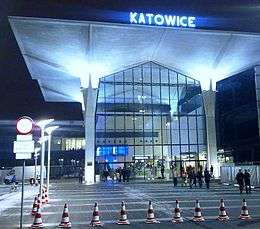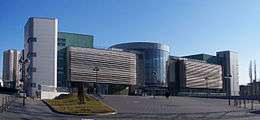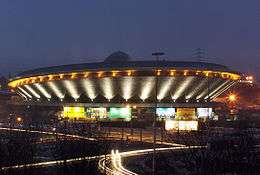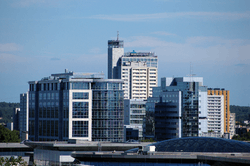Silesian Metropolis
| Silesian Metropolis Metropolia Silesia | |
|---|---|
|
Katowice Financial Center | |
 Silesian Metropolis | |
| Coordinates: 50°15′N 19°0′E / 50.250°N 19.000°ECoordinates: 50°15′N 19°0′E / 50.250°N 19.000°E | |
| Country | Poland |
| Voivodship | Silesia |
| Council | Zarząd GZM |
| Government | |
| • Head of Council | Marcin Krupa |
| Area | |
| • City | 1,586.16 km2 (612.42 sq mi) |
| Population (30 June 2015) | |
| • City | 2,204,325 |
| • Density | 1,400/km2 (3,600/sq mi) |
| • Urban | 2,746,000 |
| • Metro | 5,294,000 |
| Time zone | CET (UTC+1) |
| • Summer (DST) | CEST (UTC+2) |
| Area code(s) | +48 32 |
| Vehicle registration | SD, SG, SH, SI, SJ, SK, SL, SM, SO, ST, SW, SY, SZ, SBE, SBL, SGL, SPI, SRS, SMI, STA |
| Economy | service industries, business |
| Highway |
E40 / A4: Berlin-MAUS-Kiev E75 / A1: Tricity-MAUS-Bratislava |
| Railway |
Berlin-MAUS Vienna-MAUS Prague-MAUS Hamburg-MAUS Bratislava-MAUS-Warsaw |
| Airport | Katowice International Airport |
| Website |
www |
The Silesian Metropolis (Polish: Metropolia Silesia),[1][2] formally Metropolitan Association of Upper Silesia (Polish: Górnośląski Związek Metropolitalny) is an association of municipalities composed of 14 adjacent cities in the Polish Province of Silesia. The seat of the city council is Katowice, the largest district of the Silesian Metropolis. It is often confused as a term referring the local conurbation in a geographical context, the Katowice Urban Area and Upper Silesian metropolitan area.
The Silesian Metropolis as a Katowice area lies within one of the largest urban areas in European Union. Its population is 2,204,325 (2015), within an urban zone, with a population of 2,746,460 according to Eurostat[3] and also part of the wider Silesian metropolitan area, with a population of 5,294,000 according to the European Spatial Planning Observation Network.[4]
It was created by local authorities with little or no actual public discourse. The intent to form the union was formally stated by the mayors of the participating cities, who signed a declaration to this effect on 9 January 2006 in Świętochłowice.[5] The Union's registration was signed by the Ministry of Internal Affairs and Administration of the Republic of Poland (Polish: MSWiA) on 8 June 2007 with the city of Katowice.[6][7]
In 2006 and 2007, the union planned to unite these cities into one entity, "Silesia".
The aim of the union is the creation of a strong metropolitan center with pooled resources, an internationally competitive profile and unified management of common infrastructure.
Goals
The main goals of the union include the following:
- Arriving at a common development strategy for the cities of the union, in accordance with the current law governing planning and land use
- Implementing projects joined by a common development strategy of the cities
- Obtaining financing from domestic and foreign funding sources
- Managing the roadways transferred to the union by its constituent cities
- Obtaining aid from the European Union
- Stimulating the job market throughout the constituent cities
- Supporting innovative economic programs, increasing the competitive standing of the cities
- Influencing legislative and decision-making processes in matters important to the union and affecting the union's activities
The effects of the union's activity include: improvement in managing the consortium, strengthening its economic muscle and increasing the competitive standing of the cities of the MAUS, coordination of public relations and promoting the member cities, and underscoring the importance of the region.
Geography
Location
The Metropolitan Association of Upper Silesia spans urban communities in the historical regions of Upper Silesia (the south-eastern part of Silesia) as well as Lesser Poland's Zagłębie Dąbrowskie, Silesian Voivodeship in southern Poland, within the northern portion of the Upper Silesian Coal Basin between the Vistula and Oder rivers, basically resembling just a part of the medieval Duchy of Bytom and annexing the later industrial area, formerly occupied by the Silesian-American Corporation to the east of it. Nine million people live within 100 km of Silesian Stadium at the MAUS center. Six European capitals are located within 600 kilometres from MAUS: Berlin, Vienna, Prague, Bratislava, Budapest and Warsaw.
Districts
Outside of the area, the formation of the union appears to have less support than within it. Originally 17 cities were to enter into the union; due to technicalities in Polish law which could have prevented its legalization, only 14 of the 17 cities (that is, those with the legal status of an urban county) proceeded with forming the union.

The constituent cities in decreasing order by population are as follows (data of 2008):[8]
| District | Population | Area (km²) | Density (km²) |
|---|---|---|---|
| Katowice | 312,201 | 164.67 | 1,896 |
| Sosnowiec | 222,586 | 91.06 | 2,444 |
| Gliwice | 197,393 | 133.88 | 1,474 |
| Zabrze | 189,062 | 80.40 | 2,352 |
| Bytom | 184,765 | 69.44 | 2,661 |
| Ruda Śląska | 144,584 | 77.73 | 1,860 |
| Tychy | 129,776 | 81.64 | 1,590 |
| Dąbrowa Górnicza | 128,795 | 188.73 | 682 |
| Chorzów | 113,678 | 33.24 | 3,420 |
| Jaworzno | 95,520 | 152.67 | 626 |
| Mysłowice | 74,912 | 65.75 | 1,139 |
| Siemianowice Śląskie | 71,621 | 25.5 | 2,809 |
| Piekary Śląskie | 59,061 | 39.98 | 1,477 |
| Świętochłowice | 54,525 | 13.31 | 4,097 |
| Total | 1,978,479 | 1,218 | 1,624.4 |
The borders between the constituent cities have been for decades artificial, and sometimes absurd; for example, one side of a street would belong to one city and the other to another. Nationally, the union strives to address several problems including:
- Poor recognition (often omitted from Polish maps)[9]
- Under-investment (MAUS receives the lowest per-capita allocation of EU development funds in Poland)[10]
Bordering cities
Cities bordering directly on the Silesian Metropolis (2008) are shown below.[8] Some of these cities (Będzin, Czeladź and Knurów) declared their willingness to join the Silesian Metropolis, but due to legal issues canceled their candidacy.
| City | Population | Area | Density |
|---|---|---|---|
| Tarnowskie Góry | 60,975 | 83.72 km² | 728/km² |
| Będzin | 58,639 | 37.37 km² | 1,569/km² |
| Chrzanów | 39,452 | 38.32 km² | 1,030/km² |
| Knurów | 39,449 | 33.95 km² | 1,162/km² |
| Mikołów | 38,698 | 79.20 km² | 489/km² |
| Czeladź | 34,072 | 16.38 km² | 2,080/km² |
| Łaziska Górne | 21,942 | 20.07 km² | 1,093/km² |
| Trzebinia | 20,128 | 31.94 km² | 630/km² |
| Bieruń | 19,464 | 40.67 km² | 479/km² |
| Pyskowice | 19,104 | 30.89 km² | 618/km² |
| Radzionków | 17,163 | 13.20 km² | 1,300/km² |
| Lędziny | 16,262 | 31.48 km² | 517/km² |
| Wojkowice | 9,368 | 12.79 km² | 732/km² |
| Imielin | 8,010 | 28.00 km² | 286/km² |
| Sławków | 6,866 | 36.67 km² | 187/km² |
| Total | 409,592 | 534.65 km² | 766.1/km² |
| Total with MAUS | 2,388,071 | 1752,65 km² | 1195,25/km² |
Agglomeration
MAUS is the centre of the largest urban area in Poland and one of largest in the European Union; the Katowice urban area has a population of 2.7 million. The area flourished in the 19th and early 20th centuries, thanks to industry and natural resources. The conurbation consists of about 40 neighbouring cities, and the Silesian metropolitan area includes over 50 cities with a total population of 5 million. Katowice is also in the middle of a 7-million-population megalopolis, stretching from the Kraków region through Katowice to the Ostrava region.
Climate
The area has a humid continental climate. The average temperature is 8.2 degrees Celsius (average −1.5 °C (29 °F) in January, and 18 °C (64 °F) in July). Annual rainfall averages 608 mm. The area's characteristic light breezes blow at about 2 m/s from the west, through the Moravian Gate.
| Climate data for Katowice, central district of Silesian Metropolis | |||||||||||||
|---|---|---|---|---|---|---|---|---|---|---|---|---|---|
| Month | Jan | Feb | Mar | Apr | May | Jun | Jul | Aug | Sep | Oct | Nov | Dec | Year |
| Average high °C (°F) | 1 (34) |
3 (37) |
7 (45) |
13 (55) |
19 (66) |
21 (70) |
23 (73) |
23 (73) |
18 (64) |
13 (55) |
6 (43) |
2 (36) |
12.4 (54.3) |
| Daily mean °C (°F) | −1.5 (29.3) |
−0.5 (31.1) |
3.0 (37.4) |
8.0 (46.4) |
13.5 (56.3) |
16.0 (60.8) |
18.0 (64.4) |
17.5 (63.5) |
13.5 (56.3) |
9.0 (48.2) |
3.0 (37.4) |
−0.5 (31.1) |
8.2 (46.8) |
| Average low °C (°F) | −4 (25) |
−4 (25) |
−1 (30) |
3 (37) |
8 (46) |
11 (52) |
13 (55) |
12 (54) |
9 (48) |
5 (41) |
0 (32) |
−3 (27) |
4.0 (39.2) |
| Average precipitation cm (inches) | 3.04 (1.197) |
2.92 (1.15) |
3.24 (1.276) |
3.68 (1.449) |
5.29 (2.083) |
5.95 (2.343) |
7.37 (2.902) |
5.11 (2.012) |
4.49 (1.768) |
3.52 (1.386) |
3.76 (1.48) |
3.28 (1.291) |
60.85 (23.957) |
| Source: MSN Weather[11] | |||||||||||||
Economy
MAUS is an area of heavy concentration of industry, including coal, steel, energy, automotive, machinery and chemical. Over the last two decades, the service industry has become increasingly important.
Industry
.jpg)
MAUS is still a prominent center of Poland's coal and metal industries, and home to about a dozen coal mines operated by Katowice Coal Holding ((Polish) Katowicki Holding Węglowy) and Coal Company ((Polish) Kompania Węglowa); several steel processing plants (Huta Baildon, Huta Ferum, Huta Batory, Huta Pokój, Huta Florian, Huta Jedność, Huta Zabrze and Huta Zgoda); a foundry of nonferrous metals (Huta Metali Nieżelaznych Szopienice); about a dozen power and generating plants (Chorzów, Halemba, Jaworzno, Łagisza, Będzin, Chorzów, EC Nowa, Katowice, Miechowice, Szombierki, Szopienice, Tychy and Zabrze); two automotive plants (FSM and General Motors Manufacturing Poland); two plants producing military vehicles (Wojskowe Zakłady Mechaniczne SA maker of the KTO Rosomak, and Zakłady Mechaniczne "Bumar-Łabędy" SA, maker of the PT-91 main battle tank), several chemical companies (including fertilizers and paints) and other industrial establishments.
Business and commerce
Katowice is a large and dynamic business and trade-fair centre. Tens of international exhibitions take place every year on the Katowice International Fairgrounds and at the Spodek arena. Katowice is also the site of the second-largest business centre in Poland (second to the Warsaw business centre). Skyscrapers are located along Chorzowska and Korfantego streets in the city centre. The newest office buildings in Katowice are the Chorzowska 50 and Altus Skyscraper. Several other large office buildings are currently under construction (as of 2011). Katowice and MAUS house the Katowice Special Economic Zone (Katowicka Specjalna Strefa Ekonomiczna).
Transport
Public Transport

Public transportation consists of four branches. Additional services are operated by private companies and the state-owned railways (regional rail).
Trams
Silesian Interurbans - one of the largest tram systems in the world, in existence since 1894. The system extends more than 50 kilometers east-west, covering the following cities of the union and adjacent communities: Katowice, Będzin, Bytom, Chorzów, Czeladź, Dąbrowa Górnicza, Gliwice, Mysłowice, Ruda Śląska, Siemianowice Śląskie, Sosnowiec, Świętochłowice, and Zabrze.
Trolleybuses
Trolleybuses in Tychy are operated by MZK Tychy.
Buses
Buses and trams connect at the KZK GOP.
Roads
The area lacks a good circular road system; most east-west and north-south traffic goes directly through the city centre.
- European route E40 (France - Belgium - Germany - Silesian Metropolis - Ukraine - Russia - Uzbekistan - Kazakhstan)
- European route E75 (Norway - Finland - Silesian Metropolis - Slovakia - Hungary - Serbia - Macedonia - Croatia - Crete)
- European route E462 (Czech Republic - Silesian Metropolis)
- Motorway A1 (Czech - Silesian Metropolis - Tricity / Baltic Sea)
- Motorway A4 (Germany - Silesian Metropolis - Ukraine)
- DK1 National Road
- DK11 National Road
- DK44 National Road
- DK78 National Road
- DK79 National Road
- DK81 National Road
- DK86 National Road
- DK88 National Road
- DK94 National Road
Airports

The MAUS area is served by Katowice International Airport, located some 30 km north of Katowice's centre. With over 20 international and domestic destinations, it is by far the biggest airport in Silesia (with about 2.5 million passengers served in 2008). As of 2011, it is the third-busiest airport in Poland and growing rapidly. In July 2007 Terminal B was added, increasing the airport's capacity to 3.6 million passengers per year. Besides passenger traffic, the airport is also Poland's second-largest cargo airport, limited only by the size of the existing cargo terminal. Airlines operating from the airport include: Air France, Centralwings, EuroLOT, LOT Polish Airlines, Lufthansa and Wizz Air. There are proposals to convert the sport-aviation-serving Katowice-Muchowiec Airport into a city airport, a second international airport for lower, business-oriented traffic.
Railways
Standard gauge
Train transportation in the region is inexpensive and fairly efficient. The main railroad station is the Katowice Central Station with numerous regional, national and international passenger destinations. There are direct connections to Berlin, Hamburg, Vienna, Prague, Zilina (in Slovakia), Budapest, Kiev and Moscow. There are two other major hubs (Gliwice and Sosnowiec) and many smaller stations.

Silesian rail has a long and proud tradition, starting in 1846 when the first railroad (the Upper Silesia Railway, at that time called Oberschlesische Eisenbahn) reached the area. MAUS still contains some of the main railway nodes and exchange points of Silesia and Poland.
Broad gauge
A Broad gauge railway line, Linia Hutnicza Szerokotorowa, is notable for its ability to transport goods directly between the area covered by the Metropolitan Association of Upper Silesia and the countries of the former Soviet Union.
Narrow gauge
The Metropolitan Association of Upper Silesia also inhabits an area which is home to the longest network of narrow gauge railway in Europe. 785 mm (2 ft 6 9⁄10 in) lines are found only in the Upper Silesia region. Former industrial trains today provide a service for tourists from Bytom to the local 'lake district' and other attractions. A 900 mm (2 ft 11 1⁄2 in) recreational line 4.2 km long still operates in the Amusement-Recreation Park in Chorzów, Upper Silesia.
Water transport
- The Gliwice Canal links Gliwice Harbour to the Oder River, and thus to the waterway network across much of Germany and to the Baltic Sea.
- The Klodnica Canal is no longer used to transport goods, but is popular with leisure boaters.
Education


The area is the second-largest academic centre in Poland (after Warsaw).[12] At the Silesian Metropolis works more than 40 universities and institutions on the rights of the university, which educates 11% of the national number of students.[13] The most important institutions of post-secondary education are:
- University of Silesia
- Silesian University of Technology
- University of Economics in Katowice
- University of Music in Katowice
- Medical University of Silesia
- University of Sports in Katowice
- University of Arts in Katowice
- AGH University of Science and Technology in Kraków (department in Ruda Śląska)
- Polonia University of Częstochowa (department in Gliwice)
- University of Arts in Kraków (department in Katowice)
- Polish Academy of Sciences
Culture
Theatres
- Silesian Theatre (Teatr Śląski)
- Rialto Cinetheater
- Ateneum Theatre
- Korez Theatre
- Cogitatur Theatre
- GuGalander Theatre
- New Theatre
- Locus Theatre
- Small Theatre
- Silesian Theatre of Dance
Music

- Silesian Philharmonic (Filharmonia Śląska)
- Zabrze Philharmonic (Filharmonia Zabrzańska)
- Silesian Opera (Opera Śląska)
- Silesian Music Stage (Estrada Śląska)
- GuGalander Music Stage (Scena GuGalander)
- National Symphonic Orchestra of Polish Radio
Cinemas
- IMAX
- Multikino (13 theaters )
- Cinema City - Punkt rozrywki 44 (13 theaters )
- Cinema City - Silesia City Center (13 theaters )
- Cinema City - Ruda Śląska (8 theaters )
- Cinema City - Sosnowiec (6 theaters )
- Cinema City - Gliwice (13 theaters )
Museums


- Silesian Museum (Muzeum Śląskie)
- Muzeum Historii Katowic (Katowice History Museum)
- Muzeum Górnośląskie (Upper Silesia Museum)
- Muzeum Zamek Piastowski
- Muzeum Archidiecezjalne
- Muzeum Misyjne OO. Franciszkanów (Museum of Misyjne OO. The Franciscan Monk)
- Muzeum Biograficzne P. Stellera
- Muzeum Prawa i Prawników Polskich
- Muzeum Najmniejszych Książek Świata Zygmunta Szkocnego
- Muzeum Górnictwa Węglowego
Media
- TVP 3 Katowice
- TVS
- TVN24 - Katowice branch (TVN24 - oddział Katowice)
- Radio Katowice
- Radio Flash
- Radio eM
- Radio Roxy FM
- Radio Planeta
- Dziennik Zachodni
- Gazeta Wyborcza - Katowice office

Performance series
- Rawa Blues Festiwal - Spodek
- Metalmania - Spodek
- Mayday - Spodek
- International Competition of Conductors by Fitelberg
- International Festival of Military Orchestras
- International Exhibition of Graphic Arts (Intergrafia)
- All-Polish Festival of Directors
- Ars Cameralis Silesiae Superioris
- International Theatrical Festival (APART)
- International Conference of Dance, Festival of Dancing Art
Art galleries
- Galeria Sztuki Współczesnej BWA (Al. Korfantego 6)
- Galeria Sztuki Współczesnej Parnas (ul. Kochanowskiego 10)
- Galeria Sztuki Atelier 2 (ul. Batorego 2)
- Galeria Związku Polskich Artystów Plastyków (ul. Dworcowa 13)
- Galeria Architektury SARP (ul. Dyrekcyjna 9)
- Galeria Art-Deco (pl. Andrzeja 4)
- Galeria Fra Angelico (ul. Jordana 39)
- Galeria Akwarela (ul. Mikołowska 26)
- Galeria Marmurowa (ul. Mikołowska 26)
- Galeria Piętro Wyżej
- Galeria Sektor I
- Galeria Szyb Wilson
Nature and recreation
Parks

- Silesian Central Park (Wojewódzki Park Kultury i Wypoczynku)
- Kościuszko Park (Park im. Tadeusza Kościuszki)
- Forest Park of Katowice (Katowicki Park Leśny)
- Valley Three Ponds (Dolina Trzech Stawów)
- Zadole Park
- Bolina Park
- Skałka
- Dolomity Sportowa Dolina
- Świerklaniec Park
Nature preserves
- Bagna Nature Reserve (Rezerwat przyrody Bagna)
- Dilina Żabnika Nature Reserve (Rezerwat przyrody Dolina Żabnika)
- Las Dąbrowa Nature Reserve (Rezerwat przyrody Las Dąbrowa)
- Las Murckowski Nature Reserve (Rezerwat przyrody Las Murckowski)
- Ochojec Nature Reserve (Rezerwat przyrody Ochojec)
- Oles Nature Reserve (Rezerwat przyrody Oles)
- Płone Bagno Nature Reserve (Rezerwat przyrody Płone Bagno)
- Sasanka Nature Reserve (Rezerwat przyrody Sasanka)
- Segiet Nature Reserve (Rezerwat przyrody Segiet)
- "Żabie Doły" Nature Preserve
Tourism
Castles and palaces
- Castle in Gliwice (Zamek w Gliwicach)
- Castle in Ruda Śląska (Zamek w Rudzie Śląskiej)
- Castle in Tarnowice (Zamek w Tarnowicach)
- Sielecki Castle (Zamek Sielecki)
- Goldstein Palace (Pałac Goldsteinów)
- Godula Palace (Pałac Goduli)
- Dietl Palace (Pałac Dietla)
- Ciechanowski's Palace (Pałac Ciechanowskich)
- Mieroszewski's Palace in Sosnowiec (Dwór Mieroszewskich w Sosnowcu)
- Mieroszewski's Palace in Będzin (Pałac Mieroszewskich)
- Rheinbaben Palace (Pałac Rheinbabenów)
- Wilhelm Palace (Pałac Wilhelma)
- Winckler Palace (Pałac Wincklerów)
- Schöen Palace in Sosnowiec (Pałac Schöena w Sosnowcu)
Historical churches
- Cathedral in Katowice
- Basilica in Piekary (sanctuary)
- St. Stephen's Church
Sports
Katowice and other district of the Silesian Metropolis has a long sporting tradition and hosted the highly successful international championships (continental and the world), therein final of EuroBasket 2009 and 1975 European Athletics Indoor Championships, 1975 European Amateur Boxing Championships, 1976 World Ice Hockey Championships, 1957, 1985 European Weightlifting Championships, 1974, 1982 World Wrestling Championships, 1991 World Amateur Bodybuilding Championships, 2011 Women's European Union Amateur Boxing Championships, 2014 FIVB Men's World Championship and some other.
The Silesian Stadium is located in the center. It was a national stadium of Poland, more than 50 international matches of Poland national football team were played here as well as around 30 matches of UEFA competitions. There were also a Speedway World Championship, Speedway Grand Prix of Europe and many concerts featuring international stars.
Tourists can relax playing tennis or squash, doing water sports also sailing (for example — in Dolina Trzech Stawów), horse-riding (in Wesoła Fala and Silesian culture and refreshment park), cycling or going to one of numerous excellently equipped fitness clubs. Near the city center are sporting facilities like swimming pools (for example "Bugla", "Rolna") and in neighbourhood — golf courses (in Siemianowice Śląskie).
Best-known clubs
- Górnik Zabrze - men's football
- Ruch Chorzów - men's football
- Polonia Bytom - men's football, men's and women's ice hockey
- Szombierki Bytom - men's football
- GKS Katowice - men's football and men's ice hockey
- GKS Tychy - men's ice hockey
- Czarni Sosnowiec - women's football
- Clearex Chorzów - men's futsal
- Nova Gliwice - men's futsal
- Olimpia Piekary - men's handball
Other clubs
- Naprzód Janów - men's ice hockey
- Piast Gliwice - men's football
- AZS AWF Katowice - women's handball team playing in Polish Ekstraklasa Women's Handball League
- 1. FC Kattowitz - men's football; Polish co-champion, 1927; Upper Silesia champions 1907, 1908, 1909, 1913, 1922, 1945; third place, southeast Germany 1922
- Śląsk Świętochłowice - men's football
- Zagłębie Sosnowiec - men's football and ice hockey
- Szczakowianka Jaworzno - men's football
- Naprzód Lipiny - men's football
Notable residents
- Kurt Alder
- Marcin Baszczyński
- Ewald Cebula
- Gerard Cieślik
- Janusz Gajos
- Edward Gierek
- Jędrzej Giertych
- Maria Goeppert-Mayer
- Kurt Goldstein
- Damian Gorawski
- Jerzy Gorgoń
- August Hlond
- Otylia Jędrzejczak
- Henryk Kasperczak
- Jan Kiepura
- Wojciech Korfanty
- Jerzy Kukuczka
- Kazimierz Kutz
- Włodzimierz Lubański
- Franz Leopold Neumann
- Krzysztof Oliwa
- Lukas Podolski
- Miroslav Klose
- Daniel Podrzycki
- Roman Polko
- Jan Sawka
- Hanna Schygulla
- Władysław Szpilman
- Krzysztof Warzycha
- Ernest Wilimowski
- Sobiesław Zasada
- Aleksander Zawadzki
- Krystian Zimerman
- Leo Yankevich
Gallery
- Katowice
- Gliwice
 Bytom
Bytom Chorzów
Chorzów Dąbrowa Górnicza
Dąbrowa Górnicza
- The Spodek
- Sports Hall in Jaworzno

 "Stars" skyscrapers
"Stars" skyscrapers- Chorzowska street
 "Drapacz Chmur" - historical skyscraper
"Drapacz Chmur" - historical skyscraper
See also
References
- ↑ Metropolia Silesia - official page
- ↑ Miasta Metropolii Silesia promują się w Mediolanie - page of local government
- ↑ "CityProfiles: Katowice". The Urban Audit. Retrieved 2012. Check date values in:
|access-date=(help) - ↑ "Study on Urban Functions (Project 1.4.3)" - European Spatial Planning Observation Network, 2007
- ↑ Uchwały Rady Miejskiej w Świętochłowicach w 2006 roku (en: Resolutions of the City Council in Świętochłowice in 2006), Świętochłowice 2006
- ↑ (Polish) www.esil.pl - "Rejestracja Górnośląskiego Związku Metropolitalnego", 27 June 2007
- ↑ [http%3A%2F%2Fwww2.mswia.gov.pl%2Fdownload.php%3Fs%3D4%26id%3D5&ei=STpfUK2JAo7JswaqkYHIBA&usg=AFQjCNEfvRHU2qhPbChvI7MhLNjCJMWeNQ "Wykaz Związków Międzygminnych"] - Ministry of Interior and Administration, 2012
- 1 2 (Polish) Powierzchnia i ludność w przekroju terytorialnym w 2008 - Central Statistical Office in Poland
- ↑ (Polish) Pozytywny wizerunek regionu Źród³em sukcesu śl¹skich firm
- ↑ (Polish) http://bi.gazeta.pl/im/4/4370/m4370104.jpg.
- ↑ "Local weather forecast: Katowice".
- ↑ (English) http://www.gzm.org.pl/eng/images/plansze/edu2.jpg
- ↑ "Metropolia Silesia: Edukacja" - Official page of Silesian Metropolis
External links
- (Polish) GZM Site
- (Polish) Statute of the Metropolitan Association of Upper Silesia
- (Polish) Euroregiony
- (Polish) www.samorzad.pap.com.pl
- (Polish) www.katowice.nasze miasto.pl
- (Polish) Pomysł powstania największego miasta w Polsce - Silesii

